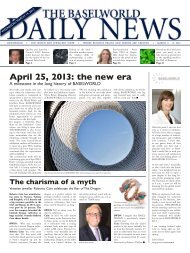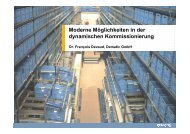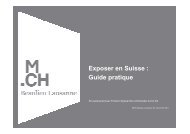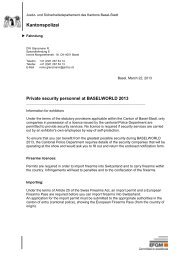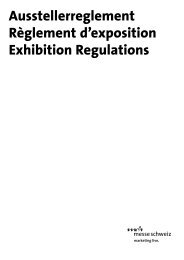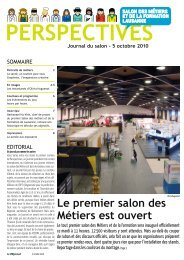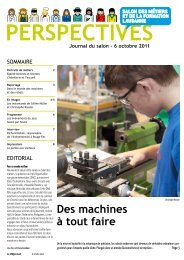WatchTime - August 2012
WatchTime - August 2012
WatchTime - August 2012
You also want an ePaper? Increase the reach of your titles
YUMPU automatically turns print PDFs into web optimized ePapers that Google loves.
... and at the ground-breaking ceremony for the new movement-making factory in Chevenez this spring<br />
Babin believes he has solved the component<br />
problem, or at least the knottiest<br />
part of it, by nailing down a reliable supply<br />
of escapement assortments to use in<br />
TAG’s in-house movements (see sidebar).<br />
His challenge now is ensuring a steady<br />
supply of finished movements.<br />
“THE TAG HEUER<br />
CHALLENGE IS<br />
TO GET TO 100,000<br />
MOVEMENTS<br />
AND MORE.”<br />
He believes he can. He buys movements<br />
from Sellita, Switzerland’s secondlargest<br />
supplier of finished movements<br />
(the Swatch Group’s ETA is, of course,<br />
number one). Even though Sellita does<br />
not have enough manufacturing capacity<br />
to fill orders for all the brands that need<br />
movements, TAG Heuer will get much of<br />
what it needs, Babin says. “[Sellita] will<br />
supply primarily those clients that have<br />
been supporting them from the very beginning.<br />
And there are two brands that<br />
have been extremely supportive: Breitling<br />
and TAG Heuer. We know that we<br />
will be on the ‘A’ list in terms of supply<br />
priority. Obviously, if I were on the ‘C’<br />
list I would be much more nervous.”<br />
In the meantime, Babin is working to<br />
expand and improve TAG’s in-house<br />
movement-making capability. In 2010,<br />
TAG introduced its first in-house movement,<br />
the 1887. Babin must now bring<br />
production costs down for both the 1887<br />
and for the more expensive movements<br />
like those used in the Mikrotimer and<br />
Mikrograph.<br />
TAG Heuer is planning to introduce<br />
another chronograph movement at the<br />
end of next year or the beginning of 2014<br />
(Babin aims to unveil it at the next Basel-<br />
world show). Unlike the 1887, which has<br />
subdials at 6, 9 and 12 o’clock, the new<br />
movement will have them at 3, 6 and 9<br />
o’clock. “We will have the two architectures<br />
that make up 100 percent of the<br />
chronograph market,” Babin says.<br />
All TAG’s in-house movements will<br />
be manufactured at a new, 2,400-squaremeter<br />
factory the company is building in<br />
the village of Chevenez in the Jura. The<br />
movement-component production that<br />
had taken place at TAG’s Cortech facility<br />
in Cornol will be moved to the new site<br />
and all of Cortech’s factory space will be<br />
dedicated to case making.<br />
“The TAG Heuer challenge is to get<br />
to 100,000 movements and more,”<br />
Babin says. Over time, the company will<br />
be able to cut production costs so that inhouse<br />
movements no longer take an excessive<br />
chunk out of profits, he believes.<br />
Nonetheless, they will never be as cheap<br />
as ETA’s: “Making it yourself costs more<br />
than buying from outside. That’s for<br />
sure.” <br />
<strong>August</strong> <strong>2012</strong> <strong>WatchTime</strong> 81





